If you’re a long time follower of Budget Bytes, you know that my freezer is my best friend. I use it to freeze leftover ingredients, leftover portions of cooked meals, and to stock up on sale items like cheese and meat. But I’ve also come to realize that there is a large grey area when it comes to freezing food. There is no clear line dividing foods that freeze well and those that don’t and there is no definitive cut off date for when frozen foods go from good to bad. That being said, I wanted to write a tutorial about how I freeze leftovers to give you a jumping off point, or a place to start experimenting with freezing food for yourselves. …Because it will take experimentation. Experimentation to find which methods produce results that you’re happy with and how to balance the effort with the savings in your own kitchen.
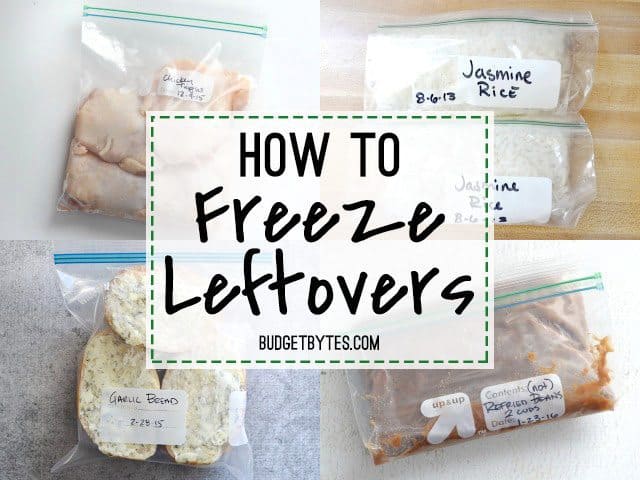
In this tutorial I’ll provide you with links to reputable resources for information about freezing food, the methods that I use to freeze my leftover meals and ingredients, as well as a nifty little printable chart I developed to keep track of the leftovers in my freezer.
Ready to get started?
Safety Guidelines
The most comprehensive information that I’ve found surrounding freezing food comes from the FDA and the National Center for Home Food Preservation. They’ve done far more research than I have (obvi) and have compiled the information into clear and concise charts and FAQs. So, read these first or at least bookmark them for future reference:
- Freezing and Food Safety FAQs
- Refrigerator and Freezer Storage Times (chart)
- Refrigerator and Freezer Storage Times (an even bigger chart, pdf)
- General Freezing Information
What Freezes Well?
That’s the question of the hour, my friends. Unfortunately, there is no definitive answer. Food undergoes a number of changes during the freeze/thaw process, and some people are more sensitive to those changes than others. Ice crystals, dehydration (aka freezer burn), and enzymes can all produce changes in the texture, appearance, and flavor of food that is stored in the freezer. These changes and how much they bother you is what makes freezing so subjective and will require your experimentation. Below are some general lists of what I think freezes well and what doesn’t.
Do Freeze: soups, stews, casseroles, saucy pasta and rice dishes, raw meat or seafood, broth, bread, cookies, baked goods, tortillas, cheese (grated or in block form), tomato paste, pesto, buttermilk, butter, ginger, cooked beans, cooked rice or pasta, fresh fruit for smoothies or baking, vegetables for soups or stews.
Do Not Freeze: cream sauces, custards, high water content vegetables (like lettuce, cucumber, tomato), sour cream, mayonnaise, fried foods, anything with gelatin.
Eggs are an item that rests comfortably in the middle. Raw eggs can be frozen if taken out of the shell, but cooked eggs tend to seep water and get over cooked when reheated. I have frozen quiches and other egg dishes with success, but I suspect not everyone would be as happy with the results as I was.
Here are some other comprehensive lists of what freezes well and what doesn’t, for comparison:
- THE CHILL FACTOR / The Guide to What Freezes, What Doesn’t, and Why
- Foods That Do Not Freeze Well
- 17 Foods You Didn’t Even Know You Can Freeze
If you’re wondering what my favorite foods are to freeze, check out my Top 10 Recipes for Freezer Leftovers.
How to Freeze Leftover Food
My goals when freezing food are to avoid freezer burn, to make the food reheatable in the portions that I need, AND to make sure the food is identifiable in a sea full of frozen foods. So, when I freeze food I ask myself: How can I package this to reduce air exposure? What portion and I likely to use or eat of this food in the future? and Is it labeled?
Step 1: Portion
I start with portioning because that happens before the food is wrapped up. I tend to freeze pieces of meat individually, so that I can thaw as little as one at a time if needed. Leftover cooked food gets frozen in individual serving size containers, so that I can reheat one meal at a time (like a homemade TV dinner!).
Cooked beans, rice, or pasta usually gets frozen in 2 cup portions (or close to the volume of one can of beans) because that’s usually about how much I’ll use in a recipe. Tomato paste, pesto, or buttermilk get frozen in 1-2 Tbsp portions. The goal of portioning is to avoid thawing all of your frozen stash when you only need to use a little. Repeated thawing and refreezing drastically reduces quality and creates many more opportunities for food safety risks.
Step 2: Package Properly
Reducing air exposure is key to preventing freezer burn and maintaining the foods’ appearance and quality. So, it’s important to use heavy duty, freezer grade products. Regular plastic wrap and original food packaging may be air permeable and won’t protect against dehydration well. So, my go-to items are quart and gallon sized freezer bags and reusable Ziploc containers (similar freezer, microwave, and dishwasher safe containers are also made by other brands).
Ziploc Containers: I use the hard sided Ziploc containers to store leftover portions of soups, stews, and casseroles. I like the containers for pre-portioned meals because they can go straight from the freezer to the microwave, without the need for dirtying more dishes.
Freezer Bags: Freezer bags are my favorite because you can squeeze out the excess air from around the food. For irregular shaped foods, I often wrap them in an extra layer of plastic within the freezer bag (or rewrap in the original packaging and place within a freezer bag), just to further reduce air flow around the food.
Step 3: Label and Date
And lastly, make sure to label and date the food. Most freezer bags come with an area that can be written on with a Sharpie, but good old fashioned masking tape works well, too. You’ll find rolls of masking tape in just about every commercial kitchen where it is critical to label and date every food item.
Guides for Freezing Specific Foods:
- How to Freeze Tomato Paste
- How to Freeze Buttermilk
- How to Freeze Rice
- How to Divide and Freeze Chicken
- How to Freeze Whole Citrus
- How to Freeze Green Onions
Tips for Freezer Success
- Chill the food completely in the refrigerator before freezing. This makes smaller ice crystals and less textural damage to the food.
- For small items (like meatballs, cookie dough, or fruit pieces), freeze while spread out on a baking sheet, then transfer to a freezer bag once solid. This prevents the pieces from clumping.
- Make sure there is room for air to flow in the freezer, which will help maintain proper temperatures.
- Label and date your food. LABEL AND DATE YOUR FOOD.
- Freeze in smaller portions when possible. This makes foods freeze faster and reduces the need to thaw more food than needed.
- “Shop” your freezer on a regular basis to stay on top of your inventory.
Free Downloadable Freezer Chart
I made this cool little chart that you can use to keep track of the leftovers you’ve frozen. This chart will help you eat your leftovers in a timely manner (before they have a chance to get freezer burn) and it will act as an “in your face” reminder of all the delicious food you have ready and waiting to be eaten at home (a take-out deterrent!).
To use this chart, simply write the name of the recipe and the date it was frozen. Next, draw a circle or square around the number of portions that you’ve frozen. Hang the chart on your fridge and every time you eat a portion, simply cross one of the portions off. Now you have a quick visual reference of your frozen meals, without having to rummage through the freezer or get numb finger tips!
**Click Here – Free Printable Freezer Chart**
How to Thaw Frozen Food
Thawing, like freezing, is often food specific. The safest way to thaw is to simply plan ahead and transfer the food to the refrigerator one day ahead. This will keep the food within a safe temperature (below 40ºF) while still allowing the food to slowly thaw.
For leftovers of cooked food (like my soups, stews, rice or pasta dishes), I often just reheat them in the microwave straight from the freezer with no thawing.
Bread, pastries, and other baked goods that are normally stored at room temperature can be thawed at room temperature. Because of the light, airy texture of bread, it thaws very quickly at room temperature, or can be placed straight into the toaster from the freezer.
If you have frozen soups, sauces, or other liquid substances in a freezer bag, simply cut the bag away and place the frozen block into a sauce pot. Reheat the liquid over low heat with a lid (to prevent dehydration), while stirring often.
Here is more comprehensive information on thawing frozen foods:
- Thawing and Preparing Food for Serving
- 5 Ways to Safely Thaw Frozen Foods
- Thawing Frozen Foods
- The Big Thaw: Safe Defrosting Methods for Consumers
The Takeaway
Freezing leftover food and ingredients can save you a LOT of cash (and hard work), so it’s worth learning how to do and getting comfortable with the process, but there is a learning curve. When in doubt, throw it out. A medical bill is almost always going to be more expensive than the few dollars you saved by not throwing away that questionable food. ;)
Feel free to share your favorite foods or ingredients to freeze in the comments below, as well as any online resources that you find helpful.


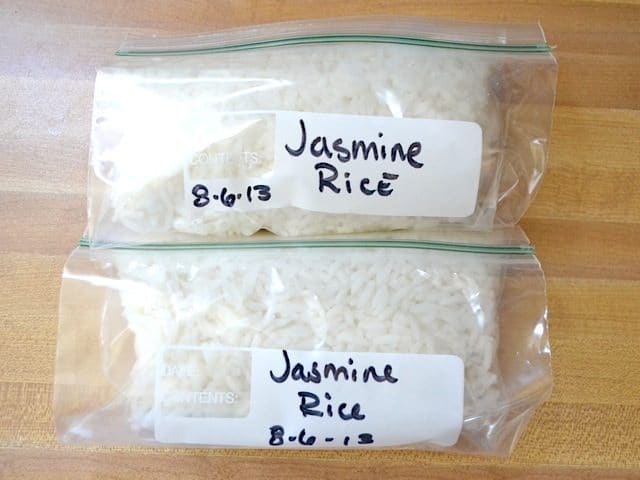
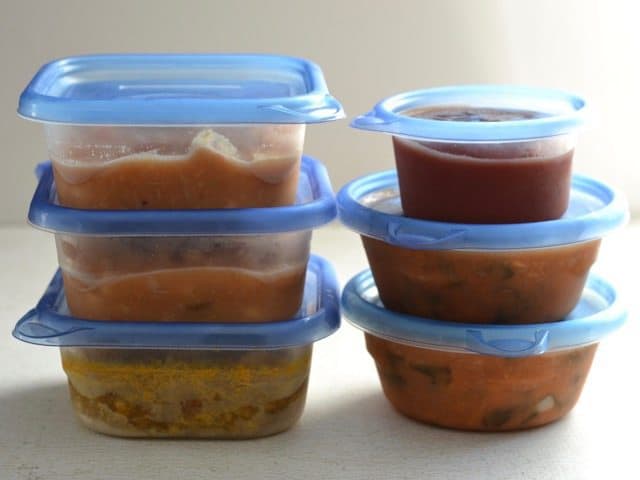
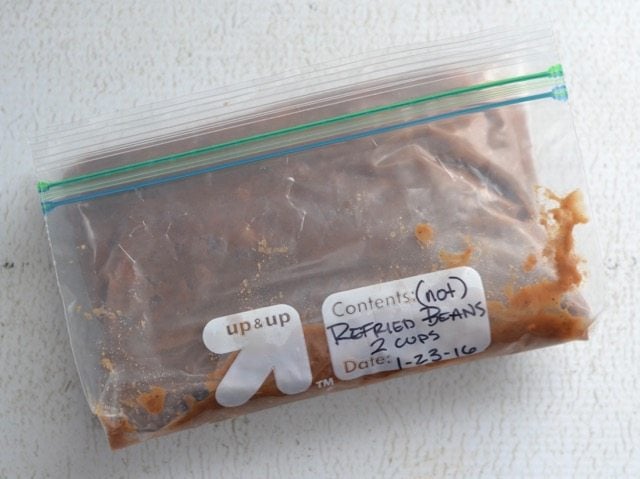

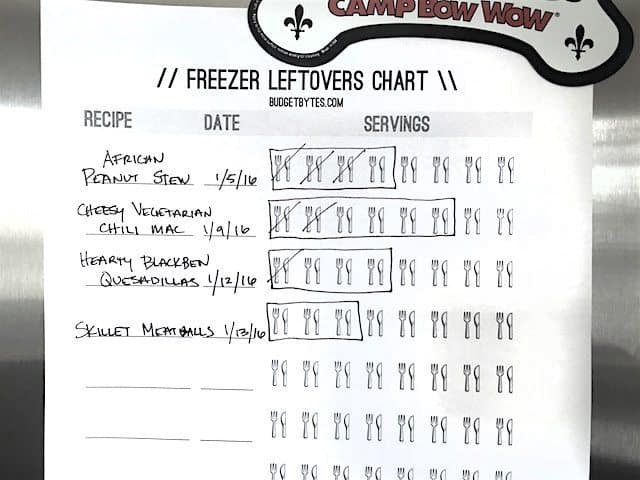
your printable freezer chart works perfectly for keeping track of how many portions of homemade baby food I freeze!! now, it’s easy to plan out what to make next and when I need to make it. thank you so much for sharing!!
THANK YOU FOR THIS!! You may be my favorite cooking blogger just because of the ease of your recipes and the comprehensive photographing, so I’m really excited for this detailed post!
Our family likes to make huge batches of our favorite dishes when the ingredients are on sale and then freeze them in single-portion containers. One thing I’ve found very helpful is to write out a ‘Meal Plan’ on our weekly grocery list, which is its own separate column to the right of the page. Any frozen meals in reserve from the past week go on the meal plan, along with the number of servings remaining, and the meal plan is posted on the fridge, so anyone on the hunt for something to eat knows what’s available and in what quantity. Then, we mark off the number of servings used, similar to the chart you found. Figuring in the meals we’ve got in the freezer each week when we’re making the grocery list saves untold dollars.
this is a great idea :)
Thanks for these freezer tips, Beth. Hard boiled eggs always get rubbery if frozen, even if they are in a soup. I learned this the hard way. My freezer is often too small for all the food I want to freeze! We periodically eat from the freezer for several nights to use anything that has been in there for more than a few weeks. My husband and I hate to waste food!
Every time I read the tip about freezing things flat or on a cookie sheet, I find myself wondering if my freezer is way smaller than average because there is no way my freezer EVER has enough room for me to be able to do that.
There are definitely half-sized cookie sheets available out there, maybe try one of those? Another option is to spread as much as possible on a plate and use that? It might take a few batches to freeze everything but it should work!
My side by side is small and I do use quarter sheets for freezing flat but that is because I use quarter sheets for most things primarily because they fit in my sink easier for washing.
But, as Andrianna said, a plate will work and if my freezer is really packed sometimes a piece of foil that I can arrange flat(ish) on top of stuff where there is room. Other options are the reusable foil baking things: bread pan, 8×8 or whatever you see that might work.
I have a very small freezer. When things call for freezing on a cookie sheet, I often use a cake pan instead.
Other commenters have left some great tips (all of which I’ve done in the past, too) and I’ve even frozen things on a cutting board before. LOL! Any flat surface that fits will work. :)
Love, love, LOOOOOVE the freezer chart!
So cute, this is going on my freezer asap!
Although I only have a small top freezer over the fridge, I freeze lots of things for future use. One thing I learned from an episode of Top Chef is to package cooked rice or noodles separately from the sauce. The ice crystals in a liquid sauce can cut into the rice or pasta making it mushy. You can package the rice in a freezer bag and the sauce in a sided container, or you can put the rice or noodles in the bottom of a storage container, add a layer of folded waxed paper, then layer the sauce on top. Just thaw the entire container in the fridge before heating the meal.
Most baked goods and casseroles can be safely frozen for about 3 months; beyond three months, it’s not that the food is unsafe, but the quality might be not as good. Raw meats can be frozen for a much longer time – up to a year in some cases, but again, poor packaging and the chance of freezer burn may affect the taste, texture and quality.
I freeze chicken portions, pork chops, and steaks in the thin plastic sandwich bags that fold over the top. When solidly frozen, I put several single serving portion of the same food in a large heavy-duty freezer zip bag.
Thanks for the printable inventory sheet!
I love using the quart-size freezer bags for freezing food. Especially when the air can be squeezed out and the food inside can be spread out through the entire bag. That way when I need to de-thaw, there’s a lot of surface area and it will thaw out faster. I usually thaw my bagged foods in water since I hardly ever think far enough ahead to throw something in the fridge the day before.
Great information. When I was in cancer treatment, I was told to never microwave in plastic. I now freeze large quantities in glass containers, move the food to a freezer bag, then move back to the glass container to cook or reheat. Smaller quantities are frozen in freezer bags then heated or cooked in glass or in metal pans or sheets.
That’s a really cool idea! And then your frozen food is bowl-shaped and ready to be reheated, right? I like this trick because it means you don’t have to tie up your glass bowls in the freezer for weeks or months, and you don’t have to worry about thawing a block-shaped soup popsicle in the microwave and having it overflow the bowl it’s in. Great idea!
My dog also digs Camp Bow Wow! :D I will use that printable chart! I already do all the other steps you listed, but sometimes a container gets pushed to the back of the freezer and goes bad before we can eat it. I hate wasting food like that.
Hahahah, I wondered if anyone would notice that! ;)
Thanks for all the tips! My absolute favorite freezing method is to portion out cooked meals (soups, stews, pastas, etc.) into paper Dixie cups – the larger size, not the bathroom size. Cover the tops with a bit of plastic wrap and freeze. Once the whole cup has frozen, use scissors to cut away the paper cup, and you are left with a single, frozen serving of the meal. Wrap the portion in Saran wrap and put them in a gallon freezer bag (I can usually fit 9 in a bag). These work well when stacked on top of one another in the freezer, or even in individual portions in the door.
I like freezing meals this way because it’s ridiculously easy to grab and go for work lunches and is super quick to heat up – two minutes in the microwave, stir, and then another two minutes. Additionally, it doesn’t require you to have a lot of Tupperware to freeze meals. Each person in your family can choose their own “cup” and heat it up accordingly.
Great technique! Thanks for sharing! :)
Good article, and love the blog still – lots of easy recipes and tips! Just one comment – it’s very wasteful using a Ziploc once, Sharpieing the information on it, and then tossing it. We always label ours with masking tape, so you can still record the date and food it contains, but then wash and reuse it after the fact. I have found that it’s impossible to get the tape to stick on a bag that is already frozen, so make sure to label it prior to putting it in the freezer.
Happy cooking!
How long do you usually keep items in the freezer? Occasionally I’ll dig something out that I never got around to eating, and I’m never quite sure what the cutoff point is for tossing vs. reheating.
Well, that part is pretty subjective. Food just kind of slowly degrades in quality over time, so there’s no real clear cut off and it’s different for every food. I try to use everything within a few months, but you can check the charts that I linked to in the beginning of the article for more specific information.
Ahhh I was so excited for this post – and I loved it! Thank you for all the great information and tips, can’t wait to step up my freezer game!
I plant extra peppers, green beans, and snow peas in my gRden and freeze them to use during the winter. They work fine in cooked dishes.
My boyfriend made an Excel spreadsheet to keep track of the items in the freezer. That way I know what I have and what date I froze it. I just change the quantity or cross off the item as I take things out. I also had him make me one for pantry staples. That way I can look at the list before I go shopping and see if I need anything. They both hang on the side of the fridge.